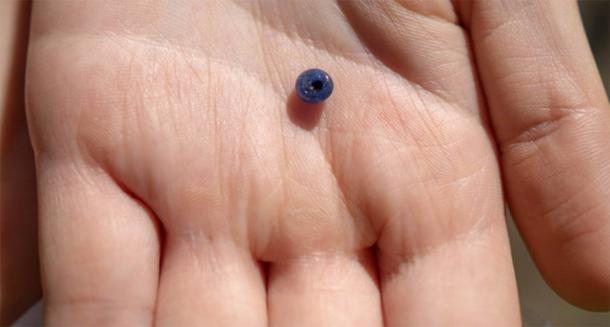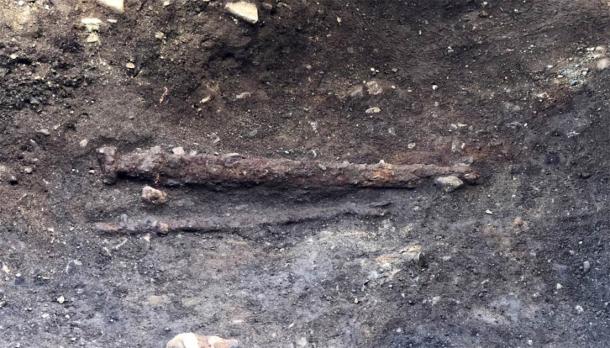Norwegian archaeologists have discovered a 1000-year-old grave containing a rare Viking sword next to the body of what must have been an equally rare left-handed (south-pawed) Norse warrior.
Vinjeøra is a village situated at the end of the Vinjefjorden (Vinje Fjord) on the European route E39 highway, about 12 kilometers south of the municipal center of Kyrksæterøra in the municipality of Heim in the Trøndelag county of Norway. It was during recent road expansion works on the E39 route through Vinjeøra that four warrior’s graves were discovered near a series of earthen mounds , and while one contained the body of a woman another yielded the remains of an 8th or 9th century local warrior who had been ceremonially buried with his spear, ax, shield and sword – but something was highly-unusual about the arrangement of this warriors grave.
Grave Evidence Included Bird Bones And A Very Heavy Sword!
The four, partially overlapping, graves were found in a circular ditch that was built around the base of one of the earthen mounds. Dr Raymond Sauvage, an archaeologist at the NTNU University Museum and project manager for the Viking warrior’s excavation, told Science Norway that he believes this burial practice is an expression of “how important the family’s ancestors were on a farm in Viking times.” The doctor explained that in the Viking Age companion ancestor spirits , called “fylgjur,” were believed to live in these burial mounds.

One of the beads found in what was likely a Viking woman’s grave in the same group of four graves where the left-handed Viking warrior was discovered. (Raymond Sauvage / NTNU University Museum )
In the same ring ditch as the warrior’s grave, researchers discovered the cremated remains of a woman with an “oval brooch, a pair of scissors and beads.” They also recovered many more bones than is normal, including bird bones . One theory is that the bones might have had “magical properties,” and that they possibly played an important role in a Viking burial ritual .
According to the Science Norway article, it was archaeologist Astrid Kviseth who finally lifted the sword from its 1000-year-old grave and placed it in its specially prepared padded box. She said that while she didn’t exactly know how heavy the sword would be, “it had some heft to it” and that you would need to be “pretty strong to be able to swing this sword!”
Viking Swords: Sacred, Named, Spiritualized Heirlooms
To Vikings, swords were exceptionally sacred, named heirlooms that were passed from father to son for generations. And in the Viking Age, swords were clear status symbols of elite warriors. Since swords were so difficult to forge, they were expensive and so swords were rare even in Viking times. Chapter 3 of the Icelandic Fóstbræðra saga states that from the “100+ weapons found in Viking Age pagan burials in Iceland, only 16 were swords.” And in Chapter 13 of Laxdæla saga the sword given by King Hákon to Höskuldur was said to be worth “a half mark of gold,” equal to the value of sixteen milk cows, a very substantial sum in the Viking Age.
Dr Sauvage said that during Viking burials in the early Middle Ages “swords were usually placed on the right side of the body in weapon graves like this,” because most people were right-handed, and therefore most warriors fastened their swords on their left side for ease of drawing. Dr Sauvage thinks the reason most swords are found on the right side is because Vikings believed the underworld was a “mirror image of the upper world.” In the newly discovered Norwegian grave, the warrior’s sword was found lying along his left side.

Swords are usually placed on the right side of the body in weapon graves like this. In this grave, it was laid on the warrior’s left side. (Ellen Grav Ellingsen / NTNU University Museum )
Viking Swords Were Rare But Lefty Warriors Were Even Rarer!
Trying to account for why this singular sword was discovered on the warriors left side, the logical side, Sauvage thinks this might have been because the Viking was “left handed,” which makes the sword, or at least the warrior, an exceptionally rare discovery. And putting this “rarity” into context, according to a 2014 paper published in Frontiers in Psychology most modern studies suggest that approximately 90% of the world population is and was right-handed, therefore, this Viking belonged to a sub-group of 10% of Norse warriors.
The discovery of this left-handed Viking warrior’s sword has caused the team of Norwegian archaeologists endless excitement, but this prized ancient artifact is currently encased in a thick crust of corrosion, but when it’s eventually analyzed the archaeologists hope x-rays might reveal “ornamentation or pattern welding in the blade,” said Kviseth. And if this is the case, and Viking symbols are indeed discovered on the blade, then the University Museum will need to sit down with their insurance adjustors to discuss the new, and greatly increased, premium.
Top image: The Viking sword discovery as it was found on the opposite side of a Norse warrior, before Astrid Kviseth placed it in specially prepared padded box. Source: Norwegian University of Science and Technology
By Ashley Cowie
Related posts:
Views: 0
 RSS Feed
RSS Feed

















 September 2nd, 2020
September 2nd, 2020  Awake Goy
Awake Goy 



 Posted in
Posted in  Tags:
Tags: 
















